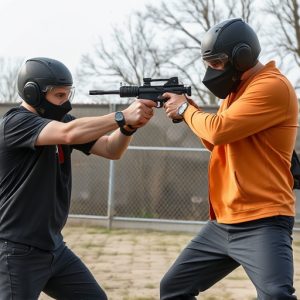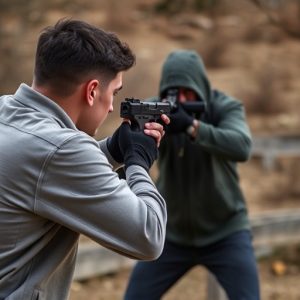Self-Defense Stun Guns: Range, Safety, and Legal Guide for College Students
Self-defense stun guns, legal and effective tools for college students' personal safety, delive…….
Self-defense stun guns, legal and effective tools for college students' personal safety, deliver high-voltage pulses to disable attackers at a safe distance (2-15 feet). As valuable as they are in today's digital age, their use comes with complex legalities. Students must understand federal and state laws, as well as campus policies, before considering carrying stun guns, balancing power and portability for optimal self-protection on campus or while traveling.
In today’s digital era, self-defense is a paramount concern, especially on bustling college campuses. Stun weapons, known for their non-lethal capabilities, offer a powerful tool for students seeking protection. This article explores the advanced technology behind stun weapon projectile range, focusing on their effectiveness in real-world scenarios. We’ll delve into the role of stun guns in enhancing campus safety, along with legal considerations and essential factors to choose the best self-defense stun gun for optimal performance.
- Understanding Stun Weapon Technology: How They Work and Their Effectiveness
- The Role of Stun Guns in College Campus Safety: Empowering Students
- Legal Considerations: Self-Defense Rights and Regulations for College Students
- Choosing the Right Stun Gun: Factors to Consider for Optimal Range and Performance
Understanding Stun Weapon Technology: How They Work and Their Effectiveness
Stun weapons, also known as electroshock weapons or self-defense stun guns, are designed to incapacitate targets with an electric current. Unlike traditional firearms, they do not cause permanent harm but rather temporarily disrupt muscle control, rendering the target unconscious for a brief period. The technology behind these devices involves high-voltage, low-amperage electrical pulses delivered through electrodes, often in the form of a gun or baton.
The effectiveness of stun weapons lies in their ability to provide a non-lethal response during self-defense situations, particularly appealing to college students seeking personal safety measures. Range capabilities vary among models but typically range from 2 to 15 feet (0.6 to 4.6 meters), depending on the device’s power output and environmental conditions. This range ensures users can maintain a safe distance while still incapacitating an attacker, making them valuable tools for individuals looking to protect themselves in close-quarter encounters, like those that might occur on college campuses.
The Role of Stun Guns in College Campus Safety: Empowering Students
Stun guns, also known as electronic control devices (ECDs), have emerged as powerful tools in the realm of self-defense stun guns for college students. With their non-lethal capabilities, these weapons offer a sense of empowerment and security on campus. Many students find comfort in knowing they can protect themselves against potential threats without resorting to lethal force. This is especially crucial in today’s digital era, where awareness about personal safety is heightened.
College campuses are bustling hubs of activity, often with large populations of young individuals navigating labyrinthine paths between classes and social events. By carrying a stun gun, students can confidently navigate these environments, feeling more in control and less vulnerable. This simple act of self-defense preparation can foster a sense of community and safety among peers, encouraging a proactive approach to personal well-being.
Legal Considerations: Self-Defense Rights and Regulations for College Students
The use of stun weapons, including stun guns and tasers, by college students for self-defense is a topic shrouded in legal complexities. Self-defense rights are a cornerstone of individual liberty, but they come with stringent regulations, especially on campuses where security measures are tightly controlled. In the United States, for instance, federal laws and individual state regulations govern the possession and use of stun devices, often categorized under non-lethal weapons. College students considering carrying a self-defense stun gun must navigate these legal landscapes to understand their rights and obligations.
Many colleges and universities have strict policies against hidden weapons on campus, aiming to foster an open and safe environment for learning. Students found in possession of stun guns without proper authorization may face severe disciplinary actions, including expulsion. However, some states allow individuals over a certain age (often 18 or more) to carry stun devices for self-defense without a permit, subject to certain restrictions. It’s crucial for college students to familiarize themselves with both federal and state laws regarding self-defense stun guns to ensure they remain compliant while protecting their safety on campus.
Choosing the Right Stun Gun: Factors to Consider for Optimal Range and Performance
When selecting a self-defense stun gun, especially for college students looking to enhance their personal safety, several factors come into play to ensure optimal range and performance. One key consideration is the device’s voltage and current output—higher values generally translate to greater stun effectiveness and a longer reach. However, it’s crucial to balance this with the weapon’s overall size and weight, as bulky devices may be less practical for carrying on campus or during travel.
Additionally, the type of trigger mechanism matters; some stun guns offer a simple press-and-shoot design, while others require a more deliberate pull. For students who might need to deploy the device quickly in stressful situations, a responsive, easy-to-use trigger can be invaluable. Durability and reliability are also essential features to look for, as stun guns should withstand regular use and various environmental conditions without compromising performance, ensuring peace of mind during an otherwise unpredictable college experience.
Stun weapons, particularly stun guns, offer college students an important tool for self-defense in enhancing campus safety. Understanding their technology, effectiveness, and legal aspects is crucial when choosing the right device to ensure optimal range and performance. By considering factors such as power output, projectile range, and reliability, students can empower themselves while navigating potential threats, ultimately contributing to a safer learning environment.


